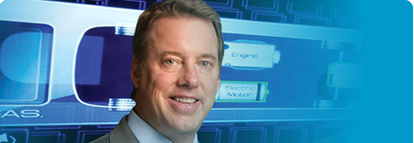Letter from William Clay Ford, Jr.

"After 100 years of evolution, the automobile industry is on the edge of a revolution, responding to the increasingly urgent need for new mobility solutions that have dramatically lower environmental impacts."
William Clay Ford, Jr.
Executive Chairman and Chairman of the Board
I have long believed that environmental sustainability is the most important issue facing businesses in the 21st century. Fortunately, unlike 20 years ago, or even five years ago, a growing number of people in our industry now agree, and we are doing something about it.
NEW DIRECTIONS IN TECHNOLOGY
After 100 years of evolution, the automobile industry is on the edge of a revolution, responding to the increasingly urgent need for new mobility solutions that have dramatically lower environmental impacts. In the auto industry, the company that can take the lead in addressing environmental concerns will have a real competitive edge. That is why Ford is investing so heavily in this area. We want to transform ourselves into a leading-edge provider of sustainable personal transportation. Over the last three years, we have spent nearly $23 billion on research and development. Right now, we are working on hybrids, plug-in hybrids, hydrogen fuel cells, hydrogen internal-combustion engines and flexible fuel vehicles in laboratories and test fleets around the world. But even revolutionary technologies will build on evolutionary steps, including improvements in transmissions, aerodynamics, weight reduction, energy storage, lubrication and others. We are also investing in these areas.
GLOBAL MOBILITY NEEDS
Other factors are transforming our Company as well. The industry is now truly global, with our customers, business partners and competitors located in all regions of the world. We believe that operating globally means more than participating in markets. It means participating in communities – acting responsibly as an employer, business partner and agent of economic development; promoting human rights in our facilities and those of our suppliers; and identifying and responding to community needs, including needs for new models of mobility. No one knows what the auto industry will look like 20 or 50 years from now. Some technological pathways will achieve breakthroughs; others will be dead ends. Some solutions will be mobility services rather than products and will emerge from a deep knowledge of the communities in which we operate.
TRANSFORMING FORD
The possibilities multiply the further out you go in time, but it is certain that the future will not look like the present. To help us explore what the future might look like and plan innovative responses, we have asked a group of sustainability thought leaders to come together several times a year with our own experts to form a Transformation Advisory Council. This group, which had its first meeting in February 2008, will help Ford scan the horizon to understand the future context for our leadership in sustainability. As I look back at the year, I am proud of the work that Ford people have done to address sustainability issues under challenging circumstances. I am particularly impressed with the leadership of Alan Mulally and Sue Cischke in developing our blueprint for sustainability, which aligns our products with the reality of a carbon-constrained world and the coming revolution in automotive technology. I hope you find this report to be as useful and candid an account of our performance and challenges as I did.
![]()
William Clay Ford, Jr.
Executive Chairman and Chairman of the Board